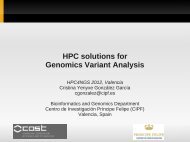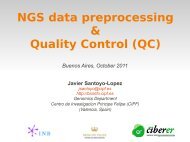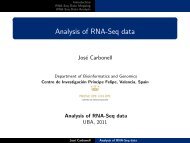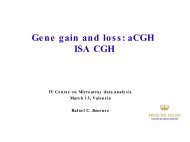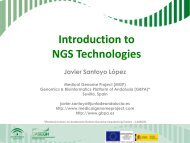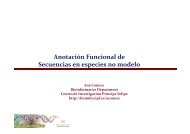Variant calling - Bioinformatics and Genomics Department at CIPF
Variant calling - Bioinformatics and Genomics Department at CIPF
Variant calling - Bioinformatics and Genomics Department at CIPF
You also want an ePaper? Increase the reach of your titles
YUMPU automatically turns print PDFs into web optimized ePapers that Google loves.
<strong>Variant</strong> <strong>calling</strong><br />
in NGS experiments<br />
Jorge Jiménez<br />
jjimeneza@cipf.es<br />
BIER CIBERER<br />
<strong>Genomics</strong> <strong>Department</strong><br />
Centro de Investigacion Principe Felipe (<strong>CIPF</strong>)<br />
(Valencia, Spain)<br />
1
Index<br />
1. NGS workflow<br />
2. <strong>Variant</strong> <strong>calling</strong><br />
3. Methods for <strong>calling</strong><br />
4. SNV <strong>and</strong> indel <strong>calling</strong><br />
5. VCF form<strong>at</strong><br />
6. Missing values<br />
7. Annot<strong>at</strong>ion<br />
8. D<strong>at</strong>abases<br />
2
NGS Sequence preprocessing<br />
Where we are?<br />
Sequence preprocessing<br />
NGS<br />
pipeline<br />
Mapping<br />
<strong>Variant</strong> <strong>calling</strong><br />
Downstream<br />
analysis<br />
3
Wh<strong>at</strong> is variant <strong>calling</strong>?<br />
Finding A Needle In The Haystack?<br />
4
<strong>Variant</strong> types<br />
SNV: Single nucleotide variant.<br />
Indel: small insertion/deletion variant.<br />
Reference<br />
SNV<br />
A<br />
G/G<br />
Small indel<br />
ATG/A<br />
5
Genotype <strong>and</strong> variant <strong>calling</strong> – concepts<br />
Phred Quality score:<br />
A score of 20 corresponds to 1% error<br />
r<strong>at</strong>e in base <strong>calling</strong><br />
<strong>Variant</strong> <strong>calling</strong>: positions with <strong>at</strong> least one of the bases differs from reference.<br />
Genotype <strong>calling</strong>: Process of determining the genotype of each variant.<br />
Importance of base quality recalibr<strong>at</strong>ion:<br />
Obtaining well-calibr<strong>at</strong>ed quality scores is important, as SNP <strong>and</strong> genotype <strong>calling</strong> <strong>at</strong> a<br />
specific position in the genome depends on both the base calls <strong>and</strong> the per-base quality<br />
scores of the reads overlapping the position.<br />
Nielsen R, Paul JS, Albrechtsen A, Song YS. Genotype <strong>and</strong> SNP <strong>calling</strong> from<br />
next-gener<strong>at</strong>ion sequencing d<strong>at</strong>a. N<strong>at</strong> Rev Genet. 2011 Jun;12(6):443-51. Review.<br />
PubMed PMID: 21587300.<br />
6
Methods for <strong>calling</strong><br />
Early methods:<br />
Counting the number of times each allele is observed.<br />
Probabilistic methods:<br />
They compute genotype likelihood.<br />
Advantages:<br />
- Provide st<strong>at</strong>istical measures of uncertainty.<br />
- Lead to higher accuracy of genotype <strong>calling</strong>.<br />
- Provide a n<strong>at</strong>ural framework for incorpor<strong>at</strong>ing inform<strong>at</strong>ion: AF, LD.<br />
7
Calling algorithms<br />
Nielsen R, Paul JS, Albrechtsen A, Song YS. Genotype <strong>and</strong> SNP <strong>calling</strong> from<br />
next-gener<strong>at</strong>ion sequencing d<strong>at</strong>a. N<strong>at</strong> Rev Genet. 2011 Jun;12(6):443-51. Review.<br />
PubMed PMID: 21587300.<br />
8
Why GATK?<br />
- Probabilistic method: Bayesian estim<strong>at</strong>ion of the most likely genotype.<br />
- Calcul<strong>at</strong>es many parameters for each position of the genome.<br />
- SNP <strong>and</strong> indel <strong>calling</strong>.<br />
- Used in many NGS projects, including the 1000 Genomes Project, The Cancer<br />
Genome Atlas, etc.<br />
- Base quality recalibr<strong>at</strong>ion.<br />
- Uses st<strong>and</strong>ard input <strong>and</strong> output files.<br />
- Many tools for manage VCF files.<br />
9
Indel <strong>calling</strong><br />
- Many available softwares like dindel, samtools, frebayes, ...<br />
- Sequence aligners are often unable to perfectly map reads containing insertions<br />
or deletions.<br />
- Indel‐containing reads can be either less unmapped or arranged in gapless<br />
alignments.<br />
- Mism<strong>at</strong>ches in a particular read can interfere with the gap.<br />
- Indel detection becomes difficult with so many missing reads.<br />
- Artifacts introduced by the gapless alignments cause the appearance of false<br />
positive SNPs (usually in clusters) → Local realignment<br />
GATK<br />
10
Local realignment<br />
Local realignment of all reads <strong>at</strong> a<br />
specific loc<strong>at</strong>ion simultaneously to<br />
minimize mism<strong>at</strong>ches to the reference<br />
genome<br />
Reduces erroneous SNPs refines<br />
loc<strong>at</strong>ion of INDELS<br />
DePristo MA, et al. A framework for vari<strong>at</strong>ion discovery <strong>and</strong> genotyping<br />
using next-gener<strong>at</strong>ion DNA sequencing d<strong>at</strong>a. N<strong>at</strong> Genet. 2011<br />
May;43(5):491-8. PMID: 21478889<br />
11
Calling all bases: missing values<br />
We want to know the genotype of all the bases of the exome.<br />
Calling:<br />
- SNVs + all sites of capture kit<br />
- indels<br />
Two types of missing values:<br />
No coverage: ./.<br />
Filtered: -/-<br />
Not sequenced base<br />
Low quality base<br />
We do not know the genotype of these bases<br />
12
Missing values<br />
?<br />
?<br />
?<br />
13
False positives <strong>and</strong> neg<strong>at</strong>ives<br />
FALSE POSITIVES:<br />
Error r<strong>at</strong>e: 1/10,000 bases<br />
False positives can be decreased by increasing the number<br />
of control <strong>and</strong> cases samples.<br />
Genes: MUC4, MUC16, ORF, ...<br />
FALSE NEGATIVES:<br />
<strong>Variant</strong>s not sequenced → missing values<br />
Errors in variants<br />
14
VCF form<strong>at</strong><br />
##[HEADER LINES]<br />
#CHROM POS ID REF ALT QUAL FILTER INFO FORMAT NA12878<br />
1 873762 . T G 5231.78 PASS [ANNOTATIONS] GT:AD:DP:GQ:PL 0/1:173,141:282:99:255,0,255<br />
1 877664 rs3828047 A G 3931.66 PASS [ANNOTATIONS] GT:AD:DP:GQ:PL 1/1:0,105:94:99:255,255,0<br />
1 899282 rs28548431 C T 71.77 PASS [ANNOTATIONS] GT:AD:DP:GQ:PL 0/1:1,3:4:25.92:103,0,26<br />
1 974165 rs9442391 T C 29.84 LowQual [ANNOTATIONS] GT:AD:DP:GQ:PL 0/1:14,4:14:60.91:61,0,255<br />
INFO fields:<br />
AC=1;AF=0.50;AN=2;DP=315;Dels=0.00;HRun=2;HaplotypeScore=15.11;MQ=91.05;MQ0=15;QD=16.61;SB=-1533.02;VQSLOD=-1.5473<br />
QD: QualByDepth. <strong>Variant</strong> confidence. Low scores are indic<strong>at</strong>ive of false positives calls <strong>and</strong> artifacts.<br />
ReadPosRankSum: Mann-Whitney Rank Sum Test for the distance from the end of the read for reads with the altern<strong>at</strong>e allele.<br />
FS: Fisher's Exact Test to detect str<strong>and</strong> bias.<br />
MQ: Root Mean Square of the mapping quality of the reads across all samples.<br />
HaplotypeScore: Consistency of the site with two (<strong>and</strong> only two) segreg<strong>at</strong>ing haplotypes.<br />
MQRankSum: Mann-Whitney Rank Sum Test for mapping qualities.<br />
More info: http://www.broadinstitute.org/gsa/wiki/index.php/Underst<strong>and</strong>ing_the_Unified_Genotyper%27s_VCF_files<br />
15
Filtering SNVs <strong>and</strong> indels<br />
Filtering parameters for SNVs <strong>and</strong> indels are different.<br />
SNVs<br />
QD < 2.0<br />
MQ < 40.0<br />
FS > 60.0<br />
indels<br />
QD < 2.0<br />
FS > 200.0<br />
ReadPosRankSum < -20.0<br />
HaplotypeScore > 13.0<br />
MQRankSum < -12.5<br />
ReadPosRankSum < -8.0<br />
##[HEADER LINES]<br />
#CHROM POS ID REF ALT QUAL FILTER INFO FORMAT NA12878<br />
1 873762 . T G 5231.78 PASS [ANNOTATIONS] GT:AD:DP:GQ:PL 0/1:173,141:282:99:255,0,255<br />
1 877664 rs3828047 A G 3931.66 PASS [ANNOTATIONS] GT:AD:DP:GQ:PL 1/1:0,105:94:99:255,255,0<br />
1 899282 rs28548431 C T 71.77 PASS [ANNOTATIONS] GT:AD:DP:GQ:PL 0/1:1,3:4:25.92:103,0,26<br />
1 974165 rs9442391 T C 29.84 STD_FILTER [ANNOTATIONS] GT:AD:DP:GQ:PL 0/1:14,4:14:60.91:61,0,255<br />
16
Some st<strong>at</strong>istics: reference positions<br />
17
Some st<strong>at</strong>istics: missing positions<br />
18
Some st<strong>at</strong>istics: variant positions<br />
19
Annot<strong>at</strong>ion<br />
Definition:<br />
An annot<strong>at</strong>ion is a note added by way of explan<strong>at</strong>ion or commentary.<br />
Annot<strong>at</strong>ion of the variants:<br />
- gene → RefSeq<br />
- consequence type.<br />
- dbSNP version 135.<br />
- alelle frequency of altern<strong>at</strong>ive allele in 1000 genomes project.<br />
- alelle frequency of altern<strong>at</strong>ive allele in NHLBI GO Exome Sequencing Project.<br />
- PolyPhen.<br />
- SIFT.<br />
- conserv<strong>at</strong>ion.<br />
- disease associ<strong>at</strong>ed to the variant.<br />
- associ<strong>at</strong>ed disease to the gene.<br />
- GO terms.<br />
20
<strong>Variant</strong><br />
Medina I, De Maria A, Bleda M, et al. "VARIANT: Comm<strong>and</strong> Line, Web service <strong>and</strong> Web interface for fast <strong>and</strong><br />
accur<strong>at</strong>e functional characteriz<strong>at</strong>ion of variants found by Next-Gener<strong>at</strong>ion Sequencing." Nucleic Acids Res..<br />
2012;40(Web Server issue):W54-8.<br />
- It can annot<strong>at</strong>e single nucleotide variants (SNVs) <strong>and</strong> insertions/deletions.<br />
- Very fast.<br />
- web server.<br />
- Input: VCF file.<br />
- Annot<strong>at</strong>ion of all the transcripts.<br />
- (...)<br />
http://variant.bioinfo.cipf.es/<br />
21
Annovar<br />
Wang K, Li M, Hakonarson H. ANNOVAR: Functional annot<strong>at</strong>ion of genetic variants from next-gener<strong>at</strong>ion sequencing<br />
d<strong>at</strong>a. Nucleic Acids Res. 2010 Sep;38(16):e164.<br />
- It can annot<strong>at</strong>e single nucleotide variants (SNVs) <strong>and</strong> insertions/deletions.<br />
- Gene-based, region-based <strong>and</strong> filter-based annot<strong>at</strong>ion of genetic variants.<br />
- Vers<strong>at</strong>ile annot<strong>at</strong>or: custom annot<strong>at</strong>ions.<br />
- Only print the worst consequence.<br />
frameshift substitution<br />
stopgain<br />
stoploss<br />
nonframeshift<br />
nonsynonymous SNV<br />
synonymous SNV<br />
unknown<br />
http://www.openbioinform<strong>at</strong>ics.org/annovar/<br />
22
Consequence type<br />
frameshift substitution<br />
stopgain<br />
stoploss<br />
nonframeshift<br />
nonsynonymous SNV<br />
synonymous SNV<br />
unknown<br />
exonic<br />
splicing<br />
ncRNA<br />
UTR5<br />
UTR3<br />
intronic<br />
upstream<br />
downstream<br />
intergenic<br />
23
SIFT/PolyPhen<br />
Assigns a “functional importance” score to SNV<br />
SIFT:<br />
Score < 0.5<br />
Score >= 0.5<br />
no benign variants<br />
benign variants<br />
http://sift.jcvi.org/<br />
PolyPhen:<br />
0<br />
1<br />
benign variants<br />
no benign variants<br />
http://genetics.bwh.harvard.edu/pph2/<br />
24
dbSNP<br />
25
1000 genomes project<br />
26
NHLBI Exome Sequencing Project (ESP)<br />
27
TO DO<br />
- Decrease number of false positives<br />
St<strong>at</strong>istical analisys to detect errors<br />
St<strong>at</strong>istical analysis to improve filters<br />
- Improve indel <strong>calling</strong><br />
- Improve annot<strong>at</strong>ion<br />
- (...)<br />
28
Questions?<br />
29




